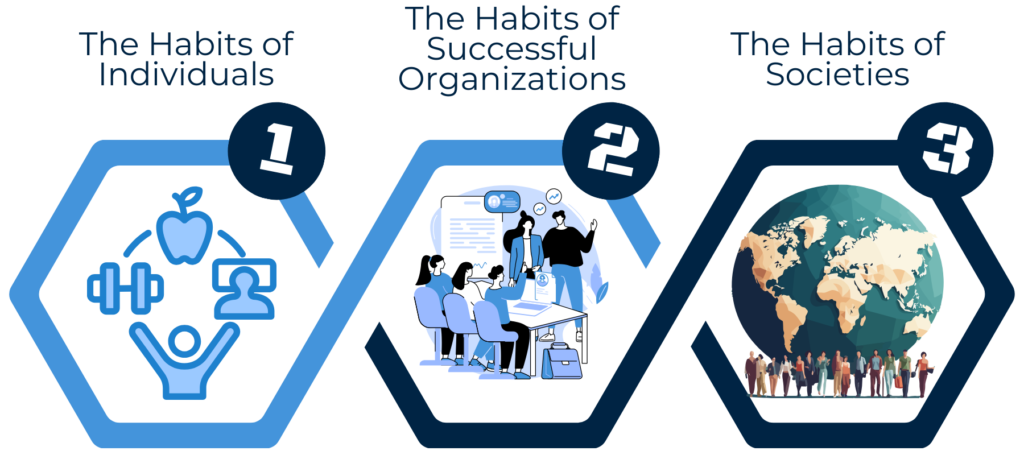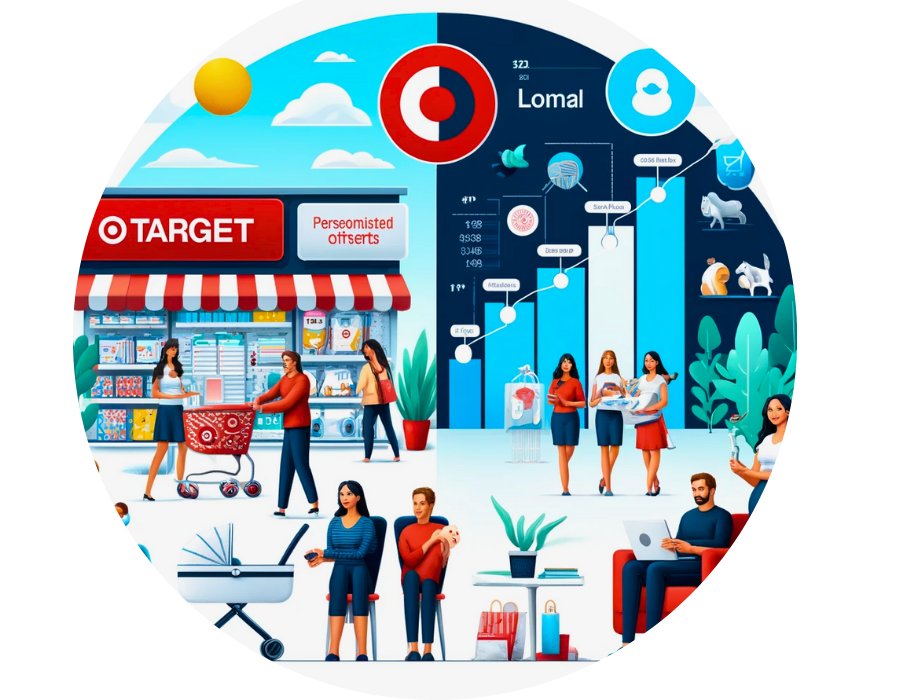In our journey towards personal growth and understanding the rhythms that govern our lives, one guide stands out for its clarity and profound insights: “The Power of Habit” by Charles Duhigg. Have you ever wondered why you instinctively reach for your phone first thing in the morning or why certain routines are so hard to break? This book is not just a read; it’s a doorway to understanding how our daily habits shape our existence and how we can mold them to forge the life we aspire to live.

In “The Power of Habit,” Charles Duhigg masterfully unveils the profound influence habits have on our lives, shaping everything from our personal routines to the success of global corporations and the dynamics of societal movements. With his keen investigative eye, Duhigg, a seasoned reporter for The New York Times, delves into the neuroscience of habit formation, presenting a compelling argument that understanding and altering our habits can drastically improve our lives.
Structured into three engaging sections, the book explores the transformative power of habits on an individual level, their pivotal role in organizational efficiency, and their capacity to effect change across societies. Through a series of captivating narratives and case studies, Duhigg brings to life the science behind habits, demonstrating how simple adjustments to our cues, routines, and rewards can lead to remarkable outcomes. From personal stories of overcoming addiction to insights into how companies like Starbucks train their employees to handle adversity, “The Power of Habit” offers both a treasure trove of fascinating examples and actionable guidance on harnessing the power of habits for positive change.
What sets this book apart is not just its insightful analysis but also its practical approach, providing readers with the tools to identify and remodel their own habits. Whether you’re looking to break a stubborn habit, improve your productivity, or understand the forces shaping societal trends, “The Power of Habit” offers a blueprint for making lasting changes in your life and the world around you.

A graduate of Yale University and Harvard Business School, Charles has been a frequent contributor to This American Life, NPR, The Colbert Report, PBS’s NewsHour, and Frontline.
Charles led the team that won the 2013 Pulitzer prize in explanatory journalism for “The iEconomy,” a series that examined the global economy through the lens of Apple. That series included examinations of such topics as the factories in China where iPhones and iPads are manufactured.
Charles has also received The George Polk award, the Gerald Loeb award, the Investigative Reporters and Editors Medal, the Scripps Howard National Journalism award, the Robert F. Kennedy Journalism Award, and other honors.
While a reporter at the Los Angeles Times, Charles reported from Iraq about American military operations.
Before becoming a full-time journalist in 2003, Charles worked as an analyst for American Property Global Partners, a private equity firm and co-founded SWPA Education Management Group, L.L.C., which developed education programs for medically underserved areas.
He was also, for one terrifying day in 1999, a bike messenger in San Francisco.
Source: https://www.charlesduhigg.com/about/ 
To deep dive into Section 1 of “The Power of Habit” by Charles Duhigg, which focuses on The Habits of Individuals, we’ll explore the foundational concepts that Duhigg uses to explain how habits are formed, how they function, and how they can be effectively changed to foster personal growth and improvement

Cues are the signals that trigger a habit to unfold. They act as a prompt for the brain to initiate a behavior automatically, without much conscious thought. Cues can come in various forms:
Identifying the cue is the first step in understanding and changing habits. It involves monitoring behaviors to detect patterns or triggers that precede the habit.
The routine is the behavior performed in response to the cue; it’s the actual habit in action. Routines can be:
Understanding that routines can be complex and multifaceted is crucial. They’re often the most visible aspect of the habit loop, making them the focus of change efforts.
Rewards are the reasons habits exist. They close the loop by satisfying a craving, making the brain remember the habit loop in the future. Rewards can be:
Rewards are critical because they teach the brain to value the routine, creating a craving that anticipates the reward whenever the cue is encountered. This anticipation becomes the driving force behind habit formation.
Takeaway: By dissecting the habit loop into these components, Duhigg provides a blueprint for changing habits. Changing a habit involves keeping the cue and reward constant while altering the routine. This approach empowers individuals to replace undesirable habits with more beneficial ones, leveraging the same cue and reward but instituting a healthier or more productive routine in response.
Understanding and manipulating the elements of the habit loop offers a powerful tool for personal development and change, underlining the core message of “The Power of Habit”: that by decoding the structure of our habits, we can transform our lives, businesses, and communities.

Michael Phelps is widely recognized as the best swimmer of all time. His unparalleled achievements in the world of competitive swimming have set him apart as a legend in the sport. Phelps’s career is highlighted by his extraordinary record of 23 Olympic gold medals, more than any other Olympian in history. His dominance in swimming spans across a variety of strokes and distances, showcasing his versatility and exceptional skill in the water. Through a combination of natural talent, rigorous training, strategic use of psychological and physical preparation, and a deep understanding of the mechanics of habit formation, Phelps has cemented his legacy as the greatest swimmer of all time.

For Phelps, the cues were meticulously designed to trigger his performance routine. These cues ranged from his pre-race rituals, such as listening to specific music to foster concentration and relaxation, to his arrival at the pool. Every aspect of his pre-race preparation was carefully choreographed, from the way he warmed up to the specific stretching exercises he performed. These cues were intended to signal his brain that it was time to engage in the highly refined routine that had been practiced countless times.

Phelps’s routine was a series of actions and mental preparations so ingrained that they became automatic. This included not only his physical warm-up and swimming technique but also a detailed visualization process dubbed “playing the videotape.” Each night before falling asleep and each morning after waking up, Phelps would visualize every aspect of his race, from diving into the pool to executing each stroke with precision. This mental rehearsal was as detailed and vivid as possible, encompassing every possible scenario, including mistakes and their immediate correction. This visualization was a critical routine that enabled Phelps to perform at his peak under pressure.

The rewards for Phelps were multifaceted. On the immediate level, successfully completing each aspect of his routine provided a sense of satisfaction and confidence. Each step, from the warm-up to the visualization, reinforced his readiness and capability to win. On a larger scale, the ultimate reward was the victory in races, the breaking of world records, and the accumulation of Olympic gold medals. These achievements not only affirmed his status as an exceptional athlete but also fulfilled his personal and professional ambitions, providing a profound sense of accomplishment and legacy.
Core Message of Michael’s Case: Through the example of Michael Phelps, Duhigg demonstrates how identifying and cultivating specific cues and routines, paired with desirable rewards, can lead to the formation of powerful habits. These habits, in turn, can propel an individual to achieve unparalleled success. Phelps’s story exemplifies how the principles outlined in “The Power of Habit” can be applied to harness the potential of habit formation to reach personal and professional goals.
This example serves as an inspiration and a model for how anyone can analyze and adapt their habits to foster success in various aspects of life, emphasizing the transformative power of the habit loop.
Continuing our exploration of Charles Duhigg’s insightful book, “The Power of Habit,” we now turn our attention from individual transformation to organizational excellence. This section not only highlights how companies can harness the science of habits to enhance efficiency, foster employee satisfaction, and drive widespread change but also delves into two illustrative case studies that demonstrate these concepts in action. Through riveting narratives and profound insights, Duhigg showcases how understanding and shaping organizational habits can lead to remarkable success and innovation. Join us as we explore the transformative stories of Paul O’Neill at Alcoa and the strategic consumer engagement at Target, providing practical examples of how habits can profoundly influence organizational dynamics. But first, let’s discover an important concept: keystone habits.

Keystone habits in organizations are essential triggers that initiate a series of beneficial changes. These cues can be both internal and external, often stemming from significant leadership decisions, strategic initiatives, or critical incidents that highlight areas needing improvement.
Internal Cues:
Internal cues often arise from within the organization, such as feedback from employees or specific events. For example, a major safety incident might prompt a company to focus intensively on workplace safety. Employee feedback on workflow inefficiencies can also serve as a cue to implement process improvements.
External Cues:
External cues can come from outside the organization, such as customer feedback, market trends, or regulatory changes. A surge in customer complaints about product quality can trigger a focus on improving manufacturing processes. Similarly, new industry regulations may prompt an organization to adopt stricter compliance measures.
Identifying these cues is crucial as they act as catalysts, encouraging the development of new, beneficial routines. Recognizing and responding to these initial signals sets the stage for transformative habits that can drive comprehensive organizational improvements.
Establishing New Practices:
The routines associated with keystone habits involve implementing consistent and repeatable actions that respond to the identified cues. These routines become embedded in the daily operations of the organization, forming the backbone of the company’s culture and processes. For instance, daily safety briefings, regular team meetings, and systematic performance evaluations can create a culture of continuous improvement and accountability. These routines are not isolated actions but interconnected practices that reinforce the keystone habit, making it a fundamental part of the organization’s operation.
Embedding in Culture:
By embedding these routines into everyday activities, organizations ensure that the keystone habits are maintained and their positive impacts are continuously realized. These routines help solidify the keystone habit, ensuring its longevity and effectiveness. Through repetition and reinforcement, the organization can maintain focus on the keystone habit, driving consistent and reliable outcomes.
Immediate Benefits:
The rewards associated with keystone habits are multifaceted and often exceed initial expectations, leading to substantial benefits across the organization. Immediate rewards can include increased productivity, improved employee morale, and higher customer satisfaction. These benefits help to anchor the keystone habit within the organizational fabric, creating a positive feedback loop that encourages the organization to maintain and expand upon these practices.
Long-Term Impact:
The long-term rewards of keystone habits extend beyond immediate gains. They contribute to overall organizational growth, greater profitability, and enhanced resilience. The tangible and intangible rewards help build a culture of excellence and continuous improvement. This feedback loop ensures that the keystone habit remains an integral part of the organization’s strategy, driving long-term success and resilience.
Reinforcing Positive Change:
The positive outcomes from keystone habits create a reinforcing loop, where the benefits generated by the habit further encourage its practice. This loop helps solidify the keystone habit within the organization’s culture, ensuring sustained impact. The consistent reinforcement of positive change fosters a culture of innovation and excellence, driving the organization towards its strategic goals.
Takeaway: By focusing on keystone habits, organizations can leverage small, strategic changes to achieve widespread transformation. These habits act as foundational elements that support and enhance various aspects of the business, leading to a more resilient, efficient, and adaptive organization. Identifying and cultivating keystone habits allows organizations to harness the power of these practices to drive significant positive change and achieve sustained success. This strategic focus on keystone habits creates a ripple effect, promoting overall organizational excellence and innovation.

In 1987, Paul O’Neill took the reins at Alcoa, an industry leader in aluminum manufacturing, known for its extensive product range and global presence. Despite its established market position, Alcoa grappled with significant safety issues, including frequent workplace injuries and fatalities. O’Neill, drawing on his extensive background in government and health sectors, chose an unconventional focus for a Fortune 500 CEO: worker safety. This decision was driven by his belief that prioritizing safety would catalyze broader organizational improvements.

In 1987, Paul O’Neill took the helm at Alcoa, a company grappling with a troubling safety record and other underlying issues that extended beyond mere financial performance.
Alcoa had been well-established in its industry, yet it was marred by frequent injuries and fatalities among its workforce. O’Neill, with a rich background in government and a keen interest in health and safety, decided to focus on an unconventional area for a Fortune 500 CEO: worker safety. This decision stemmed from his belief that by prioritizing safety, a range of broader organizational benefits would naturally follow. His strategy was rooted in the conviction that a safe working environment would not only protect employees but also lead to improved morale, productivity, and ultimately, financial performance.

Initial Steps:
Upon assuming leadership, O’Neill surprised investors by prioritizing safety over traditional financial metrics. He implemented a comprehensive safety program emphasizing daily reporting of safety issues, immediate responses to incidents, and open communication across all organizational levels. Every employee, from factory workers to executives, was empowered to halt production if safety concerns arose.
Embedding Safety:
This focus on safety fostered a culture of meticulous attention to detail and collective responsibility. The habit of safety required regular audits, safety training sessions, and investments in better equipment. These actions created an environment of continuous improvement and vigilance, encouraging proactive problem-solving and collaboration.

Immediate Benefits:
The impact of O’Neill’s safety focus was profound. Within a year, Alcoa’s safety record improved dramatically, leading the industry in low accident rates. This emphasis on safety had a ripple effect, enhancing operational efficiency and quality. Employees felt valued, boosting morale, reducing turnover, and increasing productivity.
Long-Term Impact:
Financially, Alcoa’s market value rose significantly, proving to investors that focusing on safety could drive substantial economic gains. O’Neill’s tenure at Alcoa became a celebrated example of how keystone habits can transform an organization, illustrating that focusing on seemingly peripheral aspects can lead to revolutionary changes.
Core Message of Alcoa’s Case: Paul O’Neill’s tenure at Alcoa exemplifies the profound impact a single keystone habit can have on a corporate culture and its bottom line. By focusing on safety, O’Neill not only transformed Alcoa into a safer place to work but also improved its operational efficiencies and market valuation. His strategy demonstrates that attention to what may seem like peripheral aspects of a business can indeed lead to revolutionary changes. This legacy of leadership serves as a powerful example for leaders across industries on the potential of keystone habits to drive substantial and lasting organizational change.

In the early 2000s, Target, one of America’s leading retail giants, embarked on a mission to understand and influence consumer habits to drive growth. The retail landscape was becoming increasingly competitive, with consumers bombarded by marketing messages from countless brands. To stay ahead, Target needed a way to not just attract customers, but to anticipate their needs and preferences better than its competitors.
Recognizing the potential of data analytics, Target decided to delve deeply into the patterns of consumer behavior. The goal was ambitious: to leverage advanced data analytics to predict major life events for their customers and tailor marketing efforts accordingly. By doing so, Target aimed to create a more personalized shopping experience that would foster loyalty and increase sales.
This strategic shift marked a significant transformation in how Target approached marketing and sales. Instead of relying solely on traditional marketing methods, the company invested in understanding the subtle cues and patterns that drive consumer purchases. This approach not only helped Target stand out in the crowded retail market but also set a precedent for how data analytics could be used to revolutionize retail strategies. Through a combination of cutting-edge technology and insightful analysis, Target embarked on a journey that would redefine its relationship with its customers and set the stage for remarkable growth in the highly competitive retail sector.

Target was already a well-established player in the retail market, known for offering a wide range of products at competitive prices. However, the company faced the challenge of staying ahead in a crowded market where understanding and anticipating consumer needs was becoming increasingly important.
To tackle this challenge, Target turned to data analytics, aiming to predict and influence consumer purchasing behaviors. The goal was to increase sales by identifying key life events, such as pregnancy, which often led to significant changes in shopping habits.
One particularly valuable customer segment that Target focused on was expectant mothers. Research showed that expectant mothers are highly valuable because they are at a pivotal point of establishing new shopping habits. If Target could identify these customers early, they could influence their shopping habits for years to come.
Andrew Pole, a statistician at Target, was tasked with developing an algorithm to predict pregnancy based on purchasing patterns. Through meticulous analysis, Pole and his team identified a series of cues that often preceded an announcement of pregnancy. For example, women buying unscented lotion, calcium, magnesium, zinc supplements, and large quantities of cotton balls were likely to be pregnant.

Armed with these insights, Target began sending personalized advertisements and promotions to customers identified as likely pregnant. The strategy was to subtly target these customers without making it obvious that Target was aware of their pregnancy status. This was crucial to avoid any perception of intrusion and maintain the trust of their customers.
Target employed a mixed marketing approach. Personalized mailers were sent out that included advertisements for baby-related products, such as diapers and cribs, but these were intermixed with unrelated items like lawn mowers, wine glasses, or other household goods. This blend made the promotions feel natural and prevented the customers from feeling as though their privacy was being invaded or that they were being overtly monitored.
To refine their approach, Target’s marketing team tested various formats and strategies. They discovered that including random items along with baby products in mailers reduced the likelihood of customers realizing the extent of Target’s knowledge about their personal lives. This nuanced approach helped maintain customer trust and loyalty, as the marketing efforts felt less invasive and more like a general promotion. Additionally, the team conducted focus groups and gathered customer feedback to continuously improve the effectiveness of their personalized marketing campaigns. Through these efforts, Target was able to engage customers more effectively while preserving their sense of privacy and respect

Immediate Benefits
The immediate reward for Target was a significant increase in sales among targeted customer segments. The predictive algorithm allowed Target to identify expectant mothers and engage them with timely, relevant offers. This drew new customers and deepened relationships with existing ones who appreciated the personalized shopping experience.
This approach led expectant mothers, and eventually new parents, to develop a habit of shopping at Target for all their baby needs. This habit extended beyond early parenthood, fostering long-term loyalty and increasing each customer’s lifetime value.
Long-Term Impact
The long-term rewards for Target were substantial. The success of the predictive analytics initiative demonstrated the power of understanding and influencing customer habits. This strategic use of data analytics not only boosted sales but also enhanced customer satisfaction and loyalty.
Target’s ability to anticipate and meet customer needs before they were explicitly expressed helped solidify its reputation as a customer-centric retailer. Insights from this initiative allowed Target to refine its marketing strategies, making them more effective and personalized.
Moreover, the data-driven approach to understanding customer habits became a cornerstone of Target’s broader business strategy. It fostered a culture of innovation, encouraging other departments to explore how data could drive efficiencies and improve customer experiences.
Core Message of Target’s Case: Target’s case study illustrates the profound impact of predictive analytics on consumer habits. By identifying critical life event cues and tailoring marketing strategies accordingly, Target revolutionized its approach to customer engagement. This example underscores the transformative potential of predictive analytics in retail, highlighting how understanding and responding to consumer habits can lead to remarkable business success.
The lessons from Target’s experience are clear: businesses that can decode and influence customer habits through data analytics are well-positioned to build strong, lasting relationships with their customers. This approach not only drives immediate sales but also fosters long-term loyalty and growth, setting a powerful example for other organizations seeking to harness the power of habit in their operations.
Continuing our exploration of Charles Duhigg’s insightful book, “The Power of Habit,” we now turn our attention from individual and organizational habits to the habits that shape entire societies. This section delves into how collective habits emerge, persist, and evolve, influencing societal norms, movements, and even national behaviors. Through captivating narratives and profound insights, Duhigg illustrates how understanding and shaping societal habits can lead to remarkable changes and innovations on a large scale. Join us as we explore the transformative story of the Montgomery Bus Boycott, providing a practical example of how habits can profoundly influence societal dynamics.
But first, how do Societal Habits Form?
Societal habits are not merely the aggregation of individual behaviors; they are the shared practices and rituals that define a community or nation. These habits are often reinforced by cultural norms, traditions, and collective experiences. Understanding how these habits form and evolve can provide powerful insights into how societies can be guided toward positive change. Let’s discover together the three components of this principle: Cue, Routine, and Reward.

Societal cues are the signals that trigger collective behaviors. These can be significant events, cultural symbols, or shared experiences that prompt a community to act in a certain way. For example:
Significant Events: National crises, like economic downturns or natural disasters, often prompt widespread behavioral changes.
Cultural Symbols: Iconic figures or symbols, such as flags or public figures, can serve as powerful cues that trigger collective responses.
Shared Experiences: Collective memories, such as those formed during social movements or major sporting events, can shape societal habits.
The routines associated with societal habits are the repeated actions that communities engage in response to societal cues. These routines become part of the social fabric, influencing everything from public behavior to policy decisions. Examples of societal routines include:
Public Protests: Regular demonstrations or marches that become a routine response to social injustice.
Community Rituals: Annual festivals, religious ceremonies, or national holidays that reinforce collective identities.
Social Practices: Common practices such as recycling programs, public health campaigns, or voting drives that reflect societal values.
The rewards of societal habits are the benefits that communities gain from collective behaviors. These rewards reinforce the habits, making them more likely to persist over time. Societal rewards can include:
Social Cohesion: Increased sense of community and solidarity among members.
Positive Change: Achievements such as policy reforms, improved public health, or social justice advancements.
Cultural Legacy: The lasting impact of societal habits on future generations, shaping cultural identity and national character.
Takeaway: Recognizing and understanding societal cues is crucial for identifying the triggers that lead to collective actions. By paying attention to significant events, cultural symbols, and shared experiences that act as societal cues, we can gain insights into the underlying motivations and drivers of community behavior. This understanding allows leaders, policymakers, and community organizers to strategically influence and guide positive societal behaviors. For instance, by recognizing the impact of a national crisis or the unifying power of cultural symbols, we can design interventions that harness these cues to foster unity, drive social movements, or implement public policies that address pressing issues. Ultimately, understanding societal cues helps in crafting more effective strategies for achieving lasting social change and building stronger, more cohesive communities.

One of the most powerful examples of societal habit formation is the Montgomery Bus Boycott, a pivotal event in the American Civil Rights Movement. Sparked by the arrest of Rosa Parks on December 1, 1955, for refusing to give up her seat to a white passenger, this boycott represented a collective response to systemic racial injustice. Over the course of 381 days, the African American community in Montgomery, Alabama, unified in their refusal to use the city’s buses, demonstrating remarkable resilience and solidarity. This case study illustrates how a collective habit, driven by shared values and persistent action, can lead to profound social change. Through organized efforts, such as carpooling systems and walking groups, the community maintained the boycott despite significant challenges. The Montgomery Bus Boycott not only crippled the city’s public transit system economically but also led to a Supreme Court ruling that declared bus segregation unconstitutional. This victory was a testament to the power of organized, nonviolent protest and highlighted how societal habits, when cultivated with determination and unity, can dismantle deeply entrenched systems of oppression and pave the way for broader societal transformation.

The incident of Rosa Parks became a powerful societal cue that ignited a broader movement against racial segregation. Parks’ arrest was not just an isolated act of defiance; it resonated deeply with the African American community in Montgomery, who had long been subjected to systemic discrimination and daily indignities. The arrest highlighted the pervasive injustice and served as a unifying call to action. This cue galvanized the community, transforming their collective frustration into a focused and organized effort to challenge and dismantle the institutionalized racism of the time. The Montgomery Bus Boycott emerged from this pivotal moment, demonstrating the power of a shared societal cue to spur widespread and enduring social change.

In response to Parks’ arrest, local leaders, including Dr. Martin Luther King Jr., organized a city-wide bus boycott. The routine was simple yet powerful: African Americans refused to ride the buses, opting to walk, carpool, or find alternative transportation. This routine required collective commitment and discipline, as it involved daily sacrifices and persistent effort.
The boycott was meticulously planned and supported by community meetings, church gatherings, and neighborhood discussions. The leaders established carpool networks, coordinated with local taxi drivers, and encouraged walking groups to ensure that the boycott was sustainable.

The immediate reward of the Montgomery Bus Boycott was the significant economic impact on the bus company, which relied heavily on African American passengers. The sustained boycott, lasting over a year, led to a Supreme Court ruling that declared segregation on public buses unconstitutional.
The long-term reward was even more profound. The boycott galvanized the Civil Rights Movement, demonstrating the power of collective action and nonviolent protest. It fostered a sense of unity and empowerment within the African American community, setting the stage for future civil rights campaigns.
Core Message of Montgomery’s Case The legacy of the Montgomery Bus Boycott is a testament to the transformative power of societal habits. By identifying a common cue (Rosa Parks’ arrest), establishing a persistent routine (the boycott), and achieving significant rewards (desegregation and social justice), the movement exemplified how collective habits can drive societal change.
Understanding and shaping societal habits can lead to remarkable changes in communities and nations. The Montgomery Bus Boycott illustrates how shared values, collective action, and persistent routines can transform societal norms and achieve significant social progress. By decoding the structure of societal habits, we can harness their power to drive positive change in our communities, businesses, and broader society.
In “The Power of Habit,” Charles Duhigg provides a compelling framework for understanding and transforming the habits that shape our lives, our organizations, and our societies. This book is not just a collection of insightful theories but a practical guide that empowers readers to take control of their behaviors and effect positive change. By dissecting the habit loop—cue, routine, reward—Duhigg illustrates how small adjustments can lead to profound improvements, from personal productivity and health to organizational efficiency and societal progress.
Actions for Readers:
Identify Your Cues: Reflect on the triggers that prompt your habits. Pay attention to the time, location, emotional state, and preceding actions that initiate your routines.
Analyze Your Routines: Observe your daily habits and note the specific actions you take in response to your cues. Determine whether these routines align with your goals or if they need modification.
Evaluate Your Rewards: Consider the benefits you receive from your routines. Are they fulfilling your needs and driving you towards your objectives? If not, experiment with different rewards to find what truly motivates you.
Implement Small Changes: Start with minor adjustments to your routines. For example, replace an unhealthy snack with a healthy alternative or incorporate a short exercise session into your daily schedule.
Stay Consistent: Consistency is key to forming new habits. Use reminders, set specific times, and reward yourself for sticking to your new routines.
Leverage Support Systems: Surround yourself with supportive individuals who encourage your growth. Share your goals and progress with friends, family, or a mentor to stay accountable.
Useful Resources:
Habitica: A habit-building and productivity app that gamifies your daily tasks, turning habit formation into a fun and engaging experience. www.habitica.com
Atomic Habits by James Clear: Another excellent book on habit formation, offering practical strategies for creating good habits and breaking bad ones. www.amazon.com
TED Talk: “The Power of Habit” by Charles Duhigg: A captivating talk by the author himself, summarizing key concepts from the book. www.youtube.com
Streaks: An app that helps you build good habits by tracking your streaks and providing motivation to keep going.
The Habit Loop Worksheet: A downloadable resource from Charles Duhigg’s website to help you analyze and change your habits.
Coursera Course: Learning How to Learn: A highly-rated course that teaches effective learning strategies and how to build productive habits.
By embracing the insights from “The Power of Habit” and utilizing these resources, you can unlock your potential, achieve your goals, and lead a more fulfilling life. Remember, the journey of personal growth and transformation begins with a single step—understanding and reshaping your habits. Start today, and witness the remarkable changes unfold.
